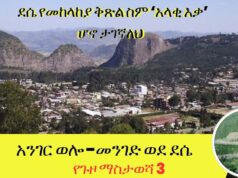Three different flags flutter in the breeze along the road that runs through Moyale in southern Ethiopia. The first is green, yellow and red: the colours of the Ethiopian federal state. Then, on the side of the road: red, black and white, with a tree in the centre, the colours of the Oromo. And a third: the green, white and red, with a camel in one corner, of Somali state.
Moyale, deep in Ethiopia’s dusty south-eastern drylands and straddling the border with Kenya, is split sharply down the middle. The fresh tarmac of the road that divides it marks the long-contested frontier between Oromia and Somali regional states.
These flags fly side-by-side in Moyale as a testament to the success of Ethiopia’s distinct model of ethnically based federalism, established in 1994.
But it is also a measure of its failings: Moyale has two separate administrations; segregated schools; parallel court systems; rivalrous police forces, and adversarial local militia. More than 20 years after ethnic federalism was introduced, tensions between the two sides – Borana Oromo and Garri Somalis – are as fraught as ever.
“There is a serious problem emerging,” said Ibrahim, an elderly Somali man in the courtyard of a hotel on the Oromo side of the road. As a clan elder, he has freedom to sit in places that younger Garri men would avoid, he said. Ill feeling between the two communities stretches back decades, but recent events have reopened old wounds.
A clash between two armed groups near Moyale in April resulted in tit-for-tat killings, with at least one Garri and one Borana reported dead (both groups claim more), and injuries on either side. Locals reported similar deadly flare-ups early this year.
Yet violence in Moyale has remained fairly contained, in part due to the town’s bloody recent past. In 2012, fighting over land between the pastoralists in the surrounding area led to 18 deaths and forced tens of thousands of Moyale’s residents to flee across the border into Kenya.
Memory of this has helped to maintain the peace since, and a community accord struck between clan elders has kept the younger generation in check. But with the latest outbreak of what he calls “revenge killings”, Ibrahim said he was worried that the accord could be broken.
Ethnic tensions here are part of a wider confrontation that stretches all along the border from Moyale in the south to Dire Dawa, some 1,000km (620 miles) north. Ethiopia’s government, the Ethiopian People’s Revolutionary Democratic Front (EPRDF), imposed a state-of-emergency in October following widespread protests against the regime in Addis Ababa, the capital, which resulted in at least 669 deaths.
But while stability returned to the rest of the country in the following months, the Somali-Oromo regional border saw an outburst of violence on a scale that many said was unprecedented. According to residents in Oromo districts along there, violent incursions by Somali militia began in December and continued sporadically over the next three months. Human Rights Watch, which received reports of dozens of casualties, said these clashes were of a different order to the pastoralist struggles over water points and farmland that have long afflicted the region in times of drought.
Instead, the clashes involved heavily armed men on both sides in locations all along the border. Schools were looted and civil servants shot in their offices, said Fekadu Adugna, an academic at Addis Ababa University, who specialises in Oromo-Somali relations.
Residents on the Oromo side also reported widespread rapes and said they had found ID cards belonging to members of the controversial Somali special police, know as the “Liyu”, among the remains of the dead. The worst of the violence took place in the area around Negele, another frontier town about 500km from Moyale.

























